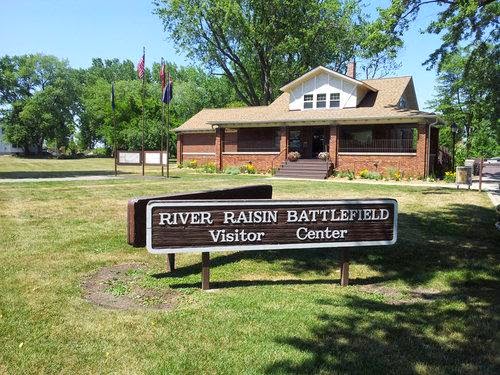As I was traveling up to the Big Ten Tournament in Detroit, I made a stop in Monroe, Michigan, at the battlefield of the River Raisin. The National Park Service has set aside some land along the River Raisin to commemorate War of 1812 battles between the US and Britain. Called Frenchtown the story of River Raisin battles tells of a US victory only to be over-shadowed by British and Native America rally and comeback victory later.
The general reason for the battle as I see it from reading the literature given out at the National Park, was generally because British ships were in control of the Great Lakes. This made it pretty impossible for the US ships to use the Great Lakes and the St. Lawrence Seaway for travel and trade. A secondary reason was before the battles at Frenchtown, a British force had overwhelmed the US at Detroit. Gen. William Hull, the US leader, surrender Detroit to the British.
The man ask to reclaim the territory was Gen. William Henry Harrison. Harrison was the Indiana Governor and the leader of their militia. He would lead an army of about 1,300 Kentuckians. Yes, I said Kentuckians, how romantic, people from Indiana and Kentucky working together! The route that they take up to Detroit was a primitive military road. Looking at this primitive military road on a map it follows the route of I-75 today, north from Dayton thru what will be Toledo and onto Michigan.
The Kentuckians joined by the local militia at Frenchtown drove out the British by the River Raisin on January 18, 1813. The fighting would last from around noon well into dark but the US forces were able to drive the British and the Native Americans out of Frenchtown. The British and their allies retreated to a town called Brownstown about 20 miles to the north.
The British and her allies were able to regroup and by the 22th of January they arrived with a force around 1,200 soldiers. The British for all intensive purposes were able to surprise the US force in the town. The British, Canadians and the Native Americans would drive the US forces across the River Raisin, with the US taking heavy causalities. Gen. James Winchester of the US forces would surrender his forces to the British on the 22th.
According to the literature on the battle, the US lost 387 men and 500 were taken prisoners. The real terror of the battle happened on the 23rd when the Native Americans kill 30 to 60 Americans prisoners. They claim is it because of the American ill-treatment of the Native Americans in the area. It is because of this battle that the rallying cry for the Americans the rest of the war will be, "Remember the Raisin."
It is interesting to learn about the War of 1812 because it is really not a war that is talked about much in US history. We like to talk about the World Wars, the Civil War and the American Revolution. Its not too far off I-75 at the Dixie Highway exit, barely 10 minutes. There is not much ground to cover in the area so it is not going to take you all day to go through the exhibits and the battlefield. I would highly recommend it, if you are in the area. A couple of link for further exploring:
National Park Service River Raisin
River Raisin Battlefield
 |
| Frenchtown |

























